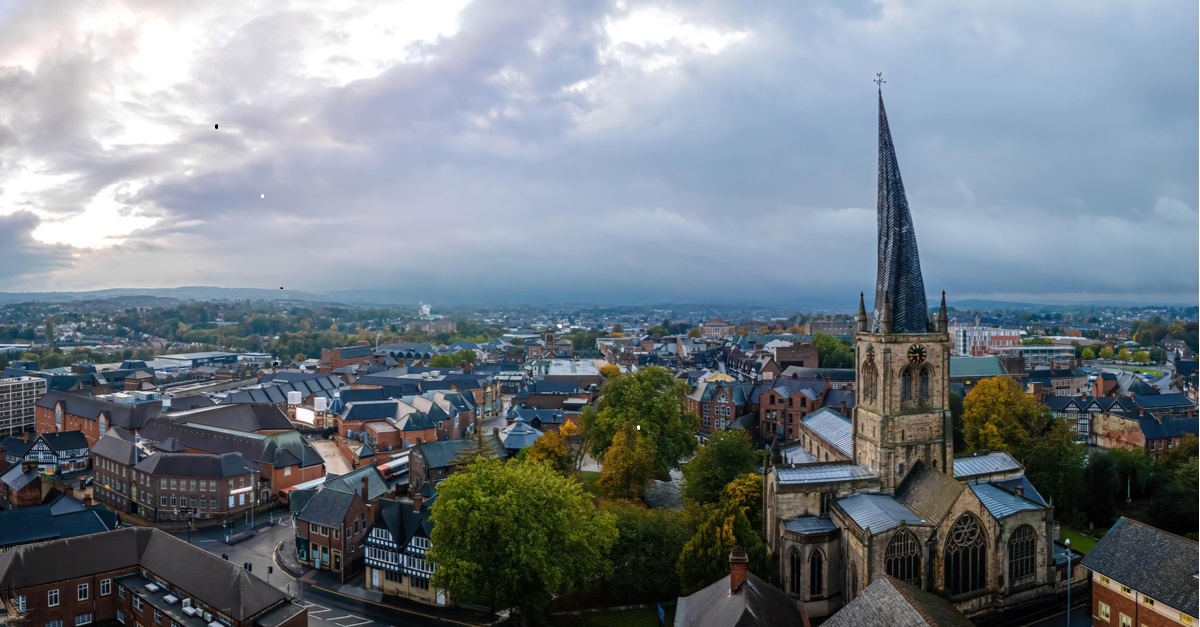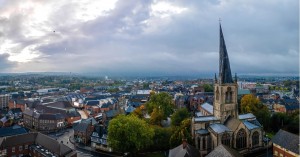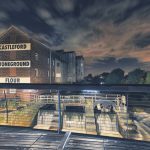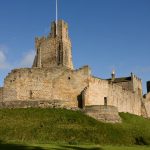
Somewhere in the lovely humid warmth of Derbyshire, you will find a town called Chesterfield. Situated at the meeting place of the Rivers Rother and Hipper, this town and borough lie in the centre of an old coalfield. In the middle of the town in the middle of the regrown coalfield, lies a church with a spiral spire that squints.
Wondering if Chesterfield is worth visiting or better still putting on your staycation list? Then join us on our quick tour of this leafy Derbyshire town starting as we usually do with a bit of the town’s history…
The Early History of Chesterfield
Chesterfield began back in the good old days when Rome invaded and conquered the old kingdoms of England. The Romans erected a fort in the area out of wood and a desire to control everything. The wood later fell, the Romans moved on, and the town was almost abandoned. The name Chesterfield came into existence thanks to the Saxon word for a fort/town combined with their word for grazing space.
The Doomsday Book
Chesterfield next pops up around the tenth century, when it was recorded as a small village. In 1086, just after the Normans invaded, the Domesday Survey ordered by William the Conqueror covered Chesterfield. It was recorded as being the land of King William, which held “2.5” households. We are not sure how you divide a household into tenths, but they managed to do it.
There were a reported 16 villagers in Chesterfield in 1086. These included 4 ploughing teams, two smallholders, and a single slave. It was valued at being worth ten pounds per year. You can view the entry yourself if you visit the Open Domesday site.
Ceasterfeld would eventually evolve to Chesterfield through the miracle of language. In 1204 they were given their own town charter. This would have allowed them to hold a weekly or monthly market day, as well as having an annual fayre. The market had been running without permission since 1165, and by 1182 the fayre had joined in.
In the middle ages, a leper hospital had grown up outside the town. It would have been avoided like the literal plague. In 1266, the Second Baron’s War was in full swing. The Battle of Chesterfield took place, wherein a group of skirmishers mopped up the opposition within the city bounds. It might even still harbour a ghost of an old soldier or two.
Medieval Times in Chesterfield
The market and fayre combo would have attracted traders from all over the region. In the 15th century, the builders created the church now famous for the twisted spire. There seems to be no reason for it other than that the wood warped over time. Nowadays, the warped spire is such a fixture of the town that it has become a carefully replicated feature whenever building work does take place.
In the 16th century, Chesterfield saw the addition of a public school, a great boost for the children of the town. In 1598 the town got a new charter which allowed it to be cleaned, swept, and plumbed in, so to speak. Chesterfield went on to endure three outbreaks of the plague between 1586 and 1608. Back then, around 20% of the population of most major English towns were wiped out. A worse plague than we have lived through and one that came in three waves.
Up until the municipal borough act of the 19th century was passed, Chesterfield continued to be led by a major and his cronies. After that point, it switched over to becoming a county borough and town on its own. As it stands now, the final expansion of the Chesterfield boundaries was in 1974.
No Industrial Revolution Here
Chesterfield didn’t have much of an industrial revolution. Mining work was carried out around the town in medieval times and any ore there would have been removed already. Chesterfield managed to largely avoid the poisoning of the land around it during the Industrial Revolution, but it didn’t get by completely unscathed. The addition of the canal in 1777 brought a new way in and out of town. This would have affected the exports but only just. The town would have mainly had wool to export, but perhaps some meat and cattle, too.
Let’s pause in the history and talk about the best fun facts from the area for a second before we pick back up in more modern times.
Top Trivia about the Town of Chesterfield
Chesterfield is a historically interesting place. As well as being the site of a Roman fort, it is also home to a twisted church spire and some awesome stories. Here are the Five Minutes Spare favourites to get you started off:
- The Royal Oak pub in town is rumoured to once have played host to the Knights Templar, circa the 16th
- Burton’s opened their first menswear shop here in 1903. It was originally owned by local resident Sir Montague Burton under the name of The Cross-Tailoring Company.
- The Police Officer originally responsible for the black and white checked police hat was the Chief constable in Chesterfield in the roaring 20s.
- It is believed that the heavy lead used to create the lopsided spire might be the only thing that is still holding it up… but we know they wouldn’t be able to keep it there if it was a health hazard, so enjoy while you can.
- That spire contains 10 different bells, all specially cast for it. The largest of them weighs over a thousand kilos.
There are a ton of things to get up to in town, too, but we will get to that in a moment. For now, let’s go back to Chesterfields’ history (there’s a train coming).
Chesterfield from the 18th century
After the canal was dug through the town, the railway failed to arrive. The man who created a famous speedy train named the Rocket was born in Chesterfield, and it must have been hard for him to spy trains. He died in the town in 1848 and is buried in a local churchyard. In 1837, while digging out the railway, locals found coal. This coal was then dug out, the ironstone beneath it extracted, and the mines left to grow green again.
Despite a lack of an Industrial Revolution, the people that lived in Chesterfield weren’t too badly off. They were granted a medical dispensary to give medicine to the poor in the year 1800. This was probably due to the prevalence of the disease in the area before this. In 1826, a gas company opened in town and began the slow process of lighting the streets. In 1881, electricity took over temporarily when a strike saw the workers in the gas plant refusing service for low pay and poor working conditions… the first of a long line of Industrial era strikes up and down the country.
In 1836, the town was given a police station, but it didn’t gain a fire brigade for another three years. The railway eventually arrived in 1841, with trams still in use up until 1882. An indoor market, a memorial hall, and a public park all followed one after the other at the end of the 19th century. As the last addition in this century, the nearby town called Brampton, known for pottery was merged into the town of Chesterfield in 1892.
The 20th Century onwards
From the start of the twentieth century, street lighting was changed to electricity. Trams ran on this electricity supply but only up until just after WWII. An engineering industry took hold, finally allowing the little town some growth. This resulted in the council having to erect social housing to clear up the overcrowded apartments in town.
In 1910 Chesterfield expanded to include nearby Hasland. Shortly after WWI, it was changed again to incorporate Newbold. The town kept growing and growing, swiftly becoming the largest trade centre in the area. Regardless, this still didn’t stop the wartime losses experienced throughout the town.
Two World Wars passed in Chesterfield. At the beginning of the first of them, some 1,500 young men from town signed up in the first draft alone. They were shipped all over France, with many accounts of fighting in the trenches recorded at the local county museum.
During the second world war, nearby factories were requisitioned for use to produce the cylinders and compressors needed for the war effort. There were barrack style buildings to house the reassigned workers, all of which would have packed their goods onto the train line and all of which crossed the same bridge. Reportedly, the Germans knew about that bridge – and its importance. Rumour has it that bombs dropped on the area at the time were supposed to be targeted at this bridge, but the bombers were working blind. They were thwarted by the total blackout of the town at the time. The bomb landed on the football field on one occurrence, as can be read about here.
Modern Chesterfield
In 1938, a new town hall was added, then in ’49, a theatre opened. The North Derbyshire Royal Hospital came in 1984, with a shopping centre added in 1981. The year 2000 saw another shopping centre added and the population rise past the 100k mark.
In 2006, the town erected a statue of George Stephenson – the train guy. He also happened to be the same man who discovered the coal and set up a mining company in the area. As much as he took from the natural surrounds of the town, he brought a lot of wealth to the area and is regarded as a symbol of pride.
Modern Chesterfield is a big town with a big appetite for loving life. It’s leafy and green, it sits in its valley as if nestled in the bosom of mother earth herself… now that the mining has been forgotten about. The town is a good place to live, with a friendly community and a neighbourly vibe to it. We love that it never became as overly industrialised as every other English town of its era… and if you look hard enough, you might just find some fossilised remains the Romans left behind.
Famous People from Chesterfield
Chesterfield isn’t just a good place to think about holidaying in, it’s also a great place to spot some famous people. We researched some of the best famous people you might run into at the supermarket, should you decide to visit Chesterfield.
- Olave Baden Powell, you’ve heard of her husband, but she was the first guide scout.
- The artist Paul Cummins is from here, as is Jane Freeman.
- Jericho lead singer Mark Shaw was from here.
- A famous chemist named Robert Robinson.
- Mark Webber, the guitarist from Pulp, is a chesterfield guy.
As you can see, they have a lot of famous people for such a seemingly forgotten northern town. That’s not even including the wider area, either, which contains even more famous faces.
Attractions found in Chesterfield
Now that you know about the history of the town, let’s talk about whether or not you want to go there. If you are planning a holiday in historic Chesterfield town, read this first so you can carefully plan an itinerary.

Image: Alexey Fedorenko/Shutterstock.com
The Parish Church of St Mary and All Saints
We can’t go another step without talking about this Chesterfield Parish church with its absurd crooked spire. Some blame it on the weight of the lead, some blame it on warped wood, but whatever caused it, the landmark has become an iconic representation of the town. Get your picture taken in front of it for an authentic Instagram photo. FYI their website address is simply “crookedspire.org”.
Bolsover Castle
The fairy tale Bolsover Castle is nearby, in all its stunning glory. Owned and run by English Heritage, tickets don’t cost much, and you get to spend as long as you like enjoying the amazing views over the stunning Derbyshire countryside. Bolsover Castle belonged to the Stuarts and was built to tower overall. You can see it from miles around on a clear day.
The Pomegranate Theatre
The Pomegranate theatre was built all the way back in the 18th century and was one of the first public entertainment centres in town. Nowadays, it is part historic landmark and part functioning theatre. See a show there, find out what’s on, or see a band, all live. The Pomegranate Theatre is owned by Chesterfield Theatres, who run another in the area. If you really want to see a show while you are in town, one of them will be running something you like.
Hardwick Hall
Hardwick Hall is a beautiful old estate for you to explore, but there is more on the grounds than you might expect. They have a working watermill in one of the outhouses. Visit the Stainsby Mill at Hardwick Estate and see it all for yourself. The hall is astonishing too, built in the 1500s, it is an excellent example of Elizabethan architecture. The watermill wasn’t added until the 19th century, which might explain why it still works.
Galleries and Museums in Chesterfield
The Chesterfield Museum is the biggest museum in town. They have an in-depth knowledge of all the town’s history in one place. They have evidence from the Roman forts, ancient finds, and detailed history of the town through the Industrial Revolution. They have whole sections devoted to local locomotive expert and coalfield exploiter George Stephenson in there, too.
There is a heritage centre in nearby Barlsborough. You will find them set next to the old schoolhouse in the town centre. It has been closed for refurbishment but should be open by the time the pandemic draws to a close. This centre preserves the history of the suburb to prevent it from being swallowed by the nearby large town as so many places have been already.
Last on our list of museums is the Revolution House. The house is named after the 1688 revolution when James II was on the throne. Rebels met famously here, on the edge of the moors, to plot the downfall of the king. Together, the men raised armies but were beaten back. Today, you can visit the house and see the furniture, exactly as it would have been in those days. They also run events throughout the year, so keep an eye on their itinerary during your stay.
For galleries, try the Chesterfield Antiques Centre of the Olympia House Antique and Craft Centre. Either will have a display of fine art you can peruse.
Sports and recreation
The local football team are Chesterfield FC – but they aren’t the only sports in town. There is a Jujitsu Academy, a swimming club, a kickboxing club, a karate class – and more. Most of the bigger teams play at the technique stadium, which is right in the centre of town.
As for golf clubs (of which every English town has at least two) you can check out Chesterfield Golf Club to the Tapton Park Golf Club, depending on your tastes. There is even a golf supplier nearby that can help you up your game with the complimentary gear.
Outdoor Attractions in the area
There is a lovely reservoir near the town where you can take pleasant woodland walks. It is known as Linacre Reservoir. There is also the Chesterfield Canal is water is your thing. The canal has several stops for tea along the walk, but the reservoir doesn’t have that. Be careful with children no matter which you choose.
The Queen’s Park, in the town centre, is a favourite come summertime. It is the best place for sunbathing, for walking through flower beds, and for letting the kids run wild outdoors to burn off that energy.
Shopping and Retail
Those that want to hit the shops on their Chesterfield visit should not be disappointed. You will find there is ample choice in mall. Check out the Pavements shopping centre, the Vicar Lane Shopping Centre, or the Ravenside Retail Park, and you should find everything that you need there.
Other Notable hotspots in Chesterfield
There are so many great sights to see and things to do in Chesterfield that we could barely cram it all into one article. As such, we are adding in the points that just missed the cut, below. Here are some other notable sights you should try to fit in if you are holidaying in Chesterfield:
- Visit the Barrow Hill Roundhouse Railway Centre if you like trains or spotting them.
- The Holmebrook Valley Park is a great nature walk to take the kids or dog on at the weekend.
- Visit Glapwell Nurseries for a browse through some plants followed by a little tea and cake.
- Sutton Scarsdale Hall is in ruins now and much of it is fenced off for safety reasons. Don’t let that stop you going, however. It’s a gorgeous shell of an old building worth seeing.
- The Westwood is another great place to enjoy the trees and walk your dog.
So, whatever your tastes are and whatever entertains you, there will be something that matches your expectations, right here in Chesterfield.
How to Get to Chesterfield?
Now that we have covered attractions, famous people, things to see and do, and the history – all that’s left is to show you the way. If you want to go to Chesterfield and don’t know how to get there, follow the loose instructions below and hope for the best.
Driving
Head north out of London and follow the M1. You won’t be able to miss the signs and if you do, maybe take your test again.
On The Train
You are looking for Chesterfield Railway Station which is on the Northern Line.
By Air
Your nearest airport is Doncaster Sheffield Airport.
By Sea
You can sail the canal, but you can’t reach the town by sea.
Five Minutes Spare
If you don’t think Chesterfield is your dream holiday destination this summer, that’s fine. However, you might find something better suited to you on our website. We have all sorts of town guides for you to choose from. Why not visit High Wycombe or see the sites of Sussex? Anything’s possible when you have five minutes spare.



